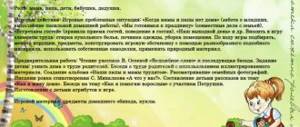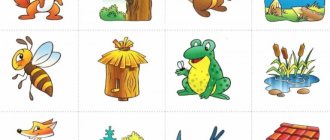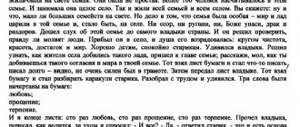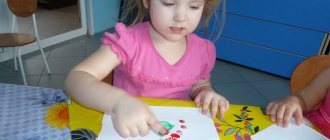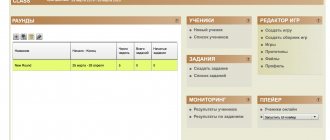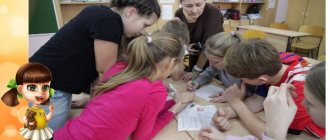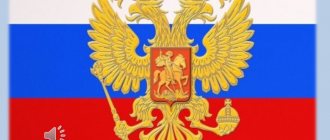Thematic role-playing game “Space” for children of the middle group
The plot-role-playing game “Space” for children of middle preschool age.
Author: Vereshchagina Oksana Viktorovna, teacher Municipal Budgetary Preschool Educational Institution, combined kindergarten No. 58, Apatity, Murmansk region. Description of the material: I offer a summary of a plot-role-playing game for children in the middle group. This material will be useful for middle school teachers. This is a summary of a plot-based role-playing game aimed at developing gaming skills, abilities and curiosity in children of middle preschool age, and at cultivating an interest in space.
Summary of the plot-role-playing game “Space” for children of middle preschool age.
Integration of educational areas: “Cognition”, “Communication”, “Socialization”, “Artistic creativity”. Goal : to introduce children to a new role-playing game. Objectives: - learn to combine several plots into one; - learn to play together; - introduce space-related professions. Vocabulary: space, astronauts, cosmodrome, spaceship, mission control center, head of the mission control center, cosmonaut training center, medical center, flight engineer, programmer, reporter photographer, meteor shower. Materials for the game: badges with inscriptions (“1 pilot”, “2 pilot”, “head of the mission control center”, “spacecraft commander”, “doctor”, “flight engineer”, “programmer”, “photographer-reporter”), riddles on the topic Space, saucer, lid, tambourine, circle, dummies (banana, carrot, apple, plum), briefcases (optional) for medical and working instruments, medical instruments (stethoscope, thermometer, etc.), working tools (pincers , hammer, etc.), computer keyboard, magnifying glass, camera, “meteor shower” (sheets of paper crumpled into balls), large construction set, chairs according to the number of children Preliminary work: teacher’s story about the first flight into space and the first cosmonaut Yuri Alekseevich Gagarin ;
reading fiction on the topic of the game, looking at illustrations on the topic “Space”. Progress of the game:
Educator: Hello, children! Today we will play a new game with you. It's called Space. We talked a lot about space and the first cosmonaut. Today we will need your knowledge. Where do you think space launches take place? Children: They take place at the cosmodrome. Educator: Correct. Who is the main person at the cosmodrome? Children: Astronauts. Educator: Let me give you a hint. He is called the head of the flight control center. What is the name of this profession? Children: She is called the head of the mission control center. Educator: Well done! Today our leader will be Tatyana Viktorovna. She will guide our flight. What other professions do you think there are still at the cosmodrome?
Children: Space flights also require astronauts, doctors, and builders. Educator: That's right. For the duration of our game, I will be the commander of the spaceship. We also need two pilots. What will be the opinions? Who will we appoint as pilots? Children: (propose candidates) Educator: We settled on the fact that Dima is the first pilot, and Oleg is the second pilot. We will also have a medical center and repair shops. Who wants to be a doctor on a spaceship? Children: (propose candidates) Educator: Okay. Let Vika be the doctor. We also need a programmer and a photographer/reporter. We need a programmer to enter data into the computer. And why do we need a photographer/reporter? Children: A photographer is needed to photograph everything and then tell it in a newspaper or magazine. Educator: That's right. Who wants to be a programmer? Children: (propose candidates). Educator: Okay. Katya will become a programmer for the duration of our flight. Who do we trust to take photographs? Children: (propose candidates). Educator: Excellent choice. Arina will be a photographer/reporter for the duration of the flight. Who wants to be a flight engineer? Children: (propose candidates) Educator: We will choose Andrey as the flight engineer. That's agreed. Now tell me, please, what do you think astronauts should be like? Children: They must be brave, strong, strong. Educator: Should they be smart? After all, not all people can become astronauts. There is so much they need to know. Children: And astronauts must be smart. Educator: Where are astronauts trained? Who knows? Children: They are trained at the school for astronauts. Educator: Not exactly. Cosmonauts undergo training at the Cosmonaut Training Center. Well, since you and I are also cosmonauts today, please imagine that we are in such a center and are undergoing training there. We have a task for you to learn about space objects. Please guess my riddles. The very first in space Flew at great speed Brave Russian guy Our cosmonaut... Children: Gagarin. Educator: Correct. On an airship, spaceship, obedient, We, overtaking the wind, are rushing on... Children: Rocket. Educator: That's right. A fragment from the planet Among the stars is rushing somewhere. He has been flying for many years - flying, Space... Children: Meteorite. Educator: Well done! The planet is blue, Beloved, dear, It is yours, it is mine, And it is called... Children: Earth. Educator: Lights up the way at night, Keeps the stars from falling asleep. Let everyone sleep, she has no time for sleep, There is light in the sky for us... Children: The moon.
Educator: Well done! Next task. Please look at this table and tell me what is unnecessary here and why. (There are replicas of a banana, an apple, a carrot and a plum on the table) Children: There is an extra carrot here. This is a vegetable, and everything else is fruit.
Educator: Here is the next task, for intelligence. Please look at these items and tell me what they have in common. (There is a saucer, a lid, a circle, a tambourine on the table).
Children: These objects are round. Educator: Well done! Well, you and I are also convinced that intellectually we all correspond to this profession. Do you think astronauts should be dexterous? Children: Yes. Educator: Let's show you that we are also dexterous. (Physical minute) Children: (perform exercises with the teacher) Educator: And now our head of the flight control center will give you a task. Head of the flight control center: You are going to the medical center, where our doctor Vika will check if everyone is healthy.
Educator: Vika, let me help you put on a medical gown (helps). And we all, one by one, approach our doctor for examination. Children: (approach the doctor who listens to them with a stethoscope)
Educator: Doctor, please tell us, is everyone healthy? Doctor: Yes, everyone is healthy. Educator: Can everyone fly into space? Doctor: Everyone can fly. Children: (rejoice). Educator: Doctor, please select all the medical instruments necessary for a flight into space. Of course you are flying with us. Doctor: (selects medical instruments).
Educator: And now we are going to the repair shops, where our technician-designer will also select the rockets necessary for repair and construction. Technician - designer: (selects tools).
Educator: The most crucial moment. Our design technician will build the rocket with our help. Let's help him. Children: (start building a rocket). Educator: Well, our rocket is ready to fly. But we won’t fit all at once. Let's use a counting rhyme to choose the flight order.
Children: (determine the order). Educator: The rocket hatch opens. Please take your seats. First pilot. Second pilot. Doctor. Technician - designer. Photographer - reporter. Programmer.
Children: (walk with their chairs, take their places)
Educator: So, the first space expedition of the middle group sets off on a flight to the moon. The head of the flight control center begins the countdown. Head of Mission Control Center: Five, four, three, two, one! Start! Educator: Here we are in space. Look how beautiful our land is from above. All in a blue glow. We are approaching the moon. Attention, we are starting to board. First pilot, start the countdown.
1 pilot: Five, four... Educator: We landed. How carefully our pilots landed the rocket! Real professionals! The hatch opens. We reach the surface of the moon. While you and I are inspecting the surface of the Moon, our design technician will check the condition of the rocket. Design technician: (checks the condition of the rocket, taps with a hammer, inspects its body) Children: (go out and walk around the rocket)
Educator: And our photographer-reporter and programmer will take photographs of the surface of the moon and enter the data into the computer. Programmer and photographer - reporter: (walk with a magnifying glass and a camera, examine, “take photographs,” “enter data into the computer”) Educator: What is this approaching the Moon and our spaceship? Attention! Danger! Meteor Rain! We all go into the rocket. “Children remaining on Earth”: (Throwing “meteorites” towards the rocket). Educator: Did everyone manage to take refuge in the rocket? Children: Yes, we all made it. Educator: Pilots, start taking off! Pilots: Five, four... Educator: We are returning to Earth.
Children: (express joy). Educator: Well, you and I have visited the Moon. Did you like the new game? Children: Yes, I liked it.
Educator: The second group of astronauts begins to prepare for the flight...
We recommend watching:
Summary of a plot-role-playing game for the middle group “Hospital” An entertainment game for children of the middle group. A plot-role-playing game for children of the middle group: Toy Store. Plot-role-playing games for kindergarten with goals. Card index
Similar articles:
Game "Cabbage" for older children
Games for middle school children in kindergarten
Developmental tasks on logic for children 4-5 years old
Attention tasks for children 4-5 years old in pictures
Cosmonautics Day in kindergarten. Middle group
Class hour "Planet of Friends"
Goals and objectives: to contribute to the formation of the moral culture of students, the expansion of experience, the creative application in real life of previously acquired knowledge, skills and abilities; cultivate a respectful attitude towards people, tolerance towards oneself and others; determine the principle of life of the class team and the team in general; develop students’ communication capabilities and the ability to communicate correctly in a team.
Equipment: balloons (according to the number of students) in blue, yellow, red and green, circles of the same color as the balloons (according to the number of students), circles with cheerful faces depicted on them, base for applique, glue, phonogram of the song “Smile” (words by M. Plyatskovsky, music by V. Shainsky).
Form of implementation: role-playing game.
Preparatory work.
Before the start of the event, students remove all desks from the classroom, leaving only chairs. The number of chairs is divided into four parts. A balloon is tied to the back of each chair. Conventionally, we get four countries: Yellow, Blue, Red and Green. There is a poster on the board with the title of the class “Planet of Friends”.
Progress of the class hour.
Teacher. - Welcome to the planet of friends. This planet is the most beautiful in the fairy-tale galaxy. Your journey along it is impossible without magical transformations. Now I will wave a magic flower, and you will turn into inhabitants of different countries on this planet.
/Students draw circles from the envelope, by the color of which they determine which country they are from.
The phonogram for the song “Little Country” (words and music by I. Nikolaev) is played. Students sit on chairs marked with the appropriate color. /
- Guys, listen to the story.
On one planet that had no name, there were only four countries: Blue Country, Yellow Country, Red Country and Green Country.
In the Blue Country, everything was blue: blue houses, blue flowers, trees, sidewalks and lanterns. And even the people were blue. In the Yellow Country, everything was yellow: the sky, roads, meadows and fields. People here are also yellow. In the Red Country everything was red, even the crocodiles. In the Green Country, as you may have guessed, everything was green.
Children in these countries were born colored, but they and their mothers and fathers, grandfathers and grandmothers loved their country very much, which means they loved the color of their skin.
It was impossible to confuse the inhabitants of these countries, since they only wore clothes of the same color. On the slogans and posters of each country it was written: “Yellow is the best!”, “Hurray for green!”, “Red is the most important!”, “Long live blue!” In each country, residents spoke only about their color and glorified it in songs and at holidays. The countries lived like this for quite a long time. The laws in the countries were strict. It was strictly forbidden to violate the borders of countries. One day, one brave boy really wanted to know how people live in other countries, what songs they sing, what games they play. We are also interested in knowing how residents of colored countries live, right? Let's take a look at each country and see what the children are doing.
/ With the help of facial expressions and gestures, some students show what the inhabitants of their country do, while others guess. /
- Guys, you have now looked very carefully and guessed what the inhabitants of the Blue Country, the Yellow Country, the Red Country and the Green Country are doing. Do you think residents of different colored countries had the same actions? Which? /Children's answers. / So, let's continue the tale. One brave boy thought: “Maybe we are not so different?” He decided to test his assumption.
- Let us also check this during the game “Stand up those who...”.
- Stand up, those who brushed their teeth today.
- Stand up, those who had breakfast today.
- Stand up, those who are wearing dresses today.
- Stand up, those who are wearing trousers today.
- Stand up, those who went to the library today.
- Stand up, those who are in a good mood today, etc.
“It turns out we have a lot in common.” The brave boy decided the same thing. He thought: “We have a lot in common. Maybe we look similar to each other?” - and he began to look closely at the inhabitants of multi-colored countries. Let's take a closer look at each other. I bring to your attention the game “Find a Pair”.
/The teacher distributes circles to the students with funny faces on them. The student finds a classmate with the same face drawn on his circle and takes his hand. /
- You see, there was a match for each of you. This happens in life: every person always has a like-minded person, you just need to take a closer look at each other.
- Let's continue the story. The brave boy took a closer look at the children from other countries: they were the same as him, only of a different color, they laughed the same way if it was funny, they also cried if it was sad. The boy didn't care what color they were. The main thing is that you can play, sing, dance, and be friends with them. Then he and his new friends decided to mix the colors, at least in a meadow among flowers. Let's try to make a multi-colored meadow.
/Students perform the collective work “Flower Meadow” using circles and glue. /
- Look at the flower meadow, is it beautiful? Residents of colorful countries also liked this idea. They decided to make friends with the residents of neighboring countries and give each country a little bit of their own color.
- Let's exchange balls too. Exchange your balloons with residents of another country.
— When the colors mixed, everyone saw how colorful and beautiful their planet had become, and friendship helped them in this.
friendship now, guys .
- Well done! Since then, the planet began to be called the “Planet of Friends” and the inhabitants of the countries became very friendly with each other.
- Let's sing a song about friendship .
/The students perform the song “Smile” (words by M. Plyatskovsky, music by V. Shainsky). /
- A fairy tale is a lie, but there is a hint in it, a lesson for good fellows. It’s not for nothing that they say: much of what we learn in a fairy tale is in our lives. Let's think about what rules people should follow in everyday life so that everyone can live comfortably on earth next to each other.
/The students offer their options: look for the best in every person; do not allow yourself to evaluate a person by his external data; fight against indifference and indifference; do not seek the superiority of one person over another; do not be afraid to do necessary and useful things; tactfully and tolerantly help a person if he does something wrong; rejoice in the successes of other people and be able to support in difficult times; show kindness and warmth. /
“I hope that there will always be mutual understanding between the students of our class and that we will be friends with each other and remember the most important law of our life: one for all and all for one.”
/At the end of the class hour, students are given a reminder. /
Memo
Remember the law of our life: one for all and all for one.
With a good friend it’s more fun when you’re lucky, and it’s easier when you’re in trouble.
Be polite with your comrades: do not give them nicknames and nicknames when talking, do not shout, do not forget to say “magic words” (“thank you”, “please”, etc.), say hello when you meet, say goodbye when parting.
If you know interesting games or know how to do something, teach others. In games, don't be rude, don't shout.
Don’t argue with your friend over trifles, don’t quarrel, try to work and play together.
Don't snitch. If a friend is wrong about something, say so right away; stop your friend if he is doing something bad.
Play with the kids, don't hurt them; if they quarrel, reconcile them, separate the fighters.
Don’t be arrogant if you’re good at something; Don’t get angry and don’t lose heart if something doesn’t work out for you.
